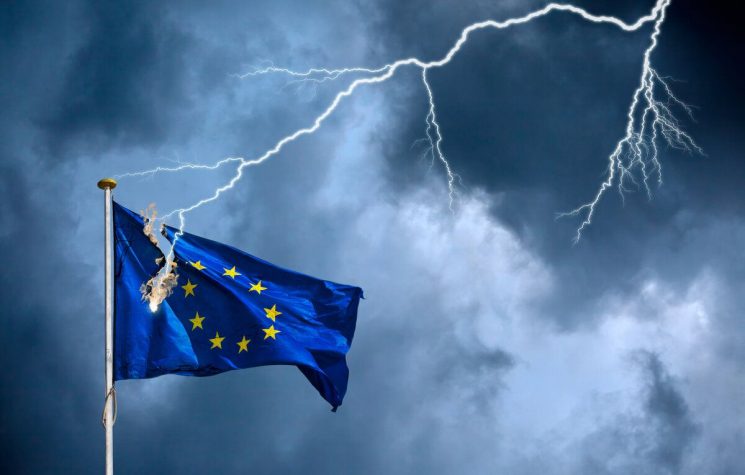Next time the New York Times or Washington Post accuses Donald Trump of fear-mongering, here’s something to keep in mind: fear-mongering is a game that both Republicans and Democrats can play – and something that both sides do.
The only difference is what they’re fear-mongering about. Where the GOP is currently beating the drum against Black Lives Matter, Antifa, and China, Dems are singing the same tune they’ve been braying since mid-2016, i.e. Russia, Russia, Russia. Otherwise, the game is the same. To quote the great Irving Berlin, the attitude in both parties is: “Anything you can do, I can do better.”
The latest example of such bipartisan one-upmanship is a spate of stories about a website known as Peacedata.net, supposedly the latest example of dastardly Russian interference in American democracy – what little is left of it, that is. Never heard of Peacedata? That’s not surprising because almost no one has. Since going public last year, its English-language web page has racked up a whopping 198 Facebook “likes” as of August. By comparison, a photo of a pit-bull puppy got 973 Facebook likes while a pair of white kittens outfitted in plaid bow ties got 875.
So Peacedata is running a distant second to button noses and floppy ears, which makes it about as threatening as an angry hamster. But that hasn’t stopped the corporate media from launching into a neo-McCarthyite panic. For the New York Times, Peacedata is a sign “that Russia and other countries were actively trying to disrupt the November election” while, for the Biden campaign, it’s “proof of two immutable facts: Russia is attempting to interfere in our elections on behalf of Donald Trump, and Facebook’s platform is a key vector for these efforts.”
Not only is Russia at fault, you see, but Trump and Facebook are as well, even though the latter is the one giving Peacedata the boot. But what about evidence? How can the dwindling number of Americans who still care about old-fashioned things be certain that the latest tale of Kremlin derring-do isn’t another dream emanating out of the Washington fever swamp known as the intelligence community?
The answer is they can’t for the simple reason that the whole thing is nonsense from beginning to end – and not just Peacedata, but everything, Russian interference, collusion, the works. Apparently, it was the FBI that uncovered Peacedata’s supposed Kremlin links and Facebook that then determined that the website is connected “to individuals associated with past activity by the Russian Internet Research Agency,” the St Petersburg-based company whose activities in the 2016 presidential election set off FBI and CIA alarm bells.
But what does a phrase like “associated with past activity” mean, exactly? Associated with what activities and how? And even if Peacedata is connected to the Internet Research Agency, what of it? The New York Times routinely describes the IRA as “Kremlin-backed.” (Examples here and here.) Yet no one has been able to prove that any such linkage exists. Special Prosecutor Robert Mueller tried, but the best he could come up with in his vastly-overrated March 2019 report was a single New York Times article describing IRA owner Yevgeny Prigozhin as “Putin’s cook” because the Russian President dined at a restaurant he owns on a number of occasions in 2001-03. This is as silly as describing Barack Obama as David Geffen’s deckhand because he’s been spotted on a yacht the Hollywood music mogul owns. Indeed, when Mueller indicted Prigozhin and the IRA in February 2018, he didn’t mention a Kremlin connection at all, undoubtedly because he knew he couldn’t prove one in a court of law. And when one of Prigozhin’s companies unexpectedly challenged the indictment in federal court, the Justice Department was forced to drop the charges altogether because they were plainly so flimsy.
So there’s no evidence linking the Internet Research Agency with the Kremlin – zero, nada, zilch. There also no real evidence that it has interfered in US elections. The money that the IRA spent on a series of Facebook ads that have sent Democrats into a collective dither – just $44,000 as of Election Day 2016 – was too piddling to have any significant impact one way or the other, while the ads themselves were so amateurish that it’s hard to believe a single voter was swayed. “I have seen all of the Russian ads,” Rob Goldman, Facebook’s vice president for advertising, tweeted in 2018, “and I can say very definitively that swaying the election was *NOT* the main goal.” To be sure, Goldman recanted within days. But the fact that he clearly did so under duress – Facebook let him go a year and a half later – makes his original statement more credible rather than less.
Indeed, no one is quite sure what the IRA was up to in placing those ads – or why it spent another $56,000 after Election Day when the task at hand had supposedly been achieved. To this day, the only explanation that is remotely plausible is the one advanced by the iconoclastic website known as Moon of Alabama – to wit, that the ads were “just another click-bait scheme” aimed at drumming up ad revenue.
Otherwise, Russian interference in 2016 is nothing but a fairy tale that members of the CIA tell little intelligence agents as they tuck them in at night. (“The Kremlin will get you if you don’t go to sleep this very instant!”) Reasonable people, assuming such elements still exist, have no more reason to believe in it than in albino crocodiles in the New York subways or pedophilia rings in Washington pizza parlors.
That goes double for Russian interference in 2020. It’s all paranoid nonsense aimed at painting Democrats as more patriotic than thou and providing them with an excuse in case they blow it in November – which they probably will.
Although the Times and Washington Post are quick to label Peacedata as disinformation, I checked out an article it posted about the crisis in Belarus and found it to be quite the opposite. Yeah, the headline about the leader of the Belarus opposition was a bit over the top: “Svetlana Tikhanovskaya’s Deleted Webpages Show She’s Little More Than a Western Regime Change Puppet.” But the piece itself, by a British journalist named Steve Topple, was balanced, informative, and well researched. It describes longtime strongman Alexander Lukashenko as “a dictator of colossal proportions” and depicts Tikhanovskaya herself as a stand-in for business interests seeking to steer a middle course between Moscow and the European Union, all of which seems accurate. It quotes a now-deleted opposition website calling on Belarus to scale back Kremlin influence, to withdraw from “post-Soviet integration associations dominated by Russia,” and integrate itself into western political and military structures such as NATO and the EU – which, if true, tells us something important about where that unfortunate country may be heading.
But Topple is careful to note that “maybe the language originally used was too forthright, or too final – hence it’s deletion.” So he’s trying to be careful when it comes to evaluating the information before him and wants readers to be careful too, which is to his credit. He concludes with a warning:
“The situation in Belarus is markedly different to that during the soft, neo-fascist and Western NeoCon-led coup known as Euromaidan in Ukraine in 2014. But the principles are the same: a country, at the crossroads between the West and Russia is caught up in a geopolitical game of chess. The people are the last thing on anyone’s minds. And as Ukraine has shown, neither Western nor Russian integration ever ends well.”
This strikes me accurate as well. It’s a good article, in short, one that is scrupulous and even-handed in its depiction of Russian and western motives and thus miles away from the simple-minded propaganda served up by the corporate media.
But that’s why the Times and Post dismiss it as disinformation – because they don’t want readers considering any viewpoint that’s not hysterical, xenophobic, or one-sided. The people who are constantly hollering about disinformation are themselves disseminating disinformation on a grand scale. What are they trying to hide?



































